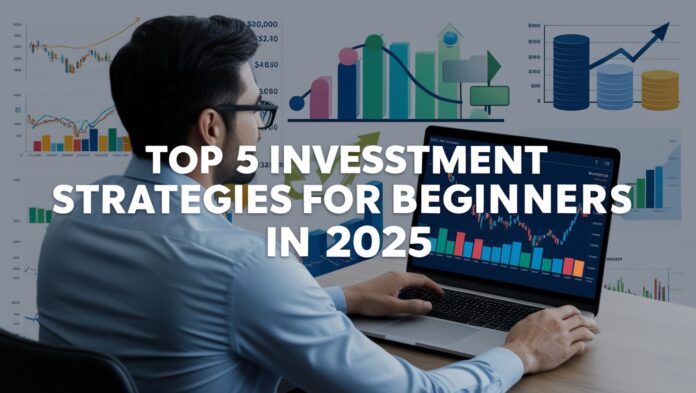Top 5 Investment Strategies for Beginners in 2025: Investing is one of the most effective ways to build wealth over time, but let’s be honest – for beginners, it can feel downright overwhelming. In 2025, the investment world is buzzing with opportunities, thanks to new platforms, educational tools, and an ever-growing list of investment options. But where do you even begin? Whether you’re just starting to dip your toes into the market or looking to refine your approach, understanding some foundational strategies can make all the difference. Here are five essential investment strategies to help beginners confidently grow their wealth while keeping risks in check.
1. Diversification: Don’t Put All Your Eggs in One Basket
Imagine you’ve got all your money invested in one stock, and suddenly that company’s value tanks. Yikes, right? Diversification is your safety net. It’s about spreading your money across different asset classes like stocks, bonds, real estate, and even commodities. By doing this, you reduce the impact of a single investment performing poorly and give yourself a more balanced portfolio.
How It Works
Think of it as building a team: if one player (investment) has a bad day, the rest of the team can still keep the game strong. For example, if the tech sector takes a hit, your investments in real estate or bonds might still hold steady.
Why It Matters
- Protects you from market volatility.
- Helps balance risks and returns over time.
- Gives you exposure to different sectors and industries, boosting growth potential.
2. Long-Term Focus: Be Patient, Stay Consistent
We all dream of quick wins, but the truth is, wealth-building takes time. A long-term approach is one of the most powerful ways to grow your investments steadily and sustainably. In 2025, tools like robo-advisors and easy-to-use platforms make it simpler than ever to stay the course.
How It Works
Instead of obsessing over daily market ups and downs, focus on the big picture. Think about investments you’re willing to hold for years or even decades. This strategy lets you benefit from compounding—the magic of earning returns on your returns.
Why It Matters
- Compounding helps your money grow exponentially.
- Long-term investing reduces the need to “time the market.”
- Staying invested helps you ride out market dips and recoveries.
3. Low-Cost Index Funds: The Beginner’s Best Friend
If you’re looking for an easy, low-risk way to get started, index funds are a fantastic option. These funds track market indexes like the S&P 500, giving you broad exposure to the market without the hefty fees of actively managed funds.
How It Works
When you invest in an index fund, your money is spread across all the companies within a specific market index. Because these funds are passively managed, they’re much cheaper to invest in—and every dollar saved on fees is a dollar staying in your pocket.
Why It Matters
- Lower fees mean more of your money is working for you.
- Broad exposure reduces the risks of individual stock performance.
- Perfect for long-term growth with minimal effort.
4. Dollar-Cost Averaging (DCA): Invest Like Clockwork
If the thought of investing during a market crash makes you break into a sweat, dollar-cost averaging (DCA) is your new best friend. This strategy involves investing a fixed amount of money at regular intervals, no matter what the market is doing.
How It Works
Let’s say you decide to invest $200 every month in an index fund. Some months, you’ll buy shares at a higher price; other months, you’ll get them for a bargain. Over time, this evens out the cost of your investments and protects you from making emotional decisions based on market swings.
Why It Matters
- Keeps you consistent, even during market downturns.
- Reduces the stress of trying to “pick the right time” to invest.
- Builds a healthy investment habit.
5. Emergency Fund: Your Safety Cushion
Before you dive headfirst into investing, make sure you’ve got an emergency fund. Life happens—whether it’s a medical bill or car trouble—and having three to six months of living expenses saved up can keep you from needing to pull money out of your investments during tough times.
How It Works
Your emergency fund should be stashed somewhere safe and accessible, like a high-yield savings account. Once you’ve built this cushion, you’ll have the confidence to take on more investment risk without constantly worrying about unexpected expenses.
Why It Matters
- Gives you financial peace of mind.
- Prevents you from selling investments during market lows.
- Sets a strong foundation for sustainable investing.
Conclusion
Starting your investment journey might feel intimidating, but it doesn’t have to be. By following these five strategies—diversifying your portfolio, focusing on the long term, embracing low-cost index funds, practicing dollar-cost averaging, and building an emergency fund—you’ll set yourself up for success in 2025 and beyond. Remember, investing isn’t about getting rich overnight. It’s about staying consistent, staying patient, and letting time do the heavy lifting. You’ve got this!

